|
My Heroes Have Always Been Plowboys
The Story of Mr. Eddie Fanick (1902 – 1994)
By Greg Grant in Neil Sperry’s Gardens in FEBRUARY, 1995
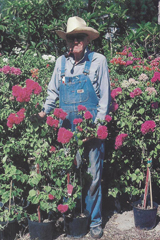 Most people have sport figures, movie stars or super heroes for idols. In the nursery industry our heroes include the likes of Luther Burbank, Robert Fortune, Ernest Wilson and Eddie Fanick of San Antonio.
Most people have sport figures, movie stars or super heroes for idols. In the nursery industry our heroes include the likes of Luther Burbank, Robert Fortune, Ernest Wilson and Eddie Fanick of San Antonio.
Mr. Fanick, now on the younger side of 92, is one of the few living heroes on the Texas horticulture scene. Founder of the legendary Fanick's Garden Center in San Antonio, he shares the common bond of a true love of plants. His nursery, founded around 1946, is not your typical retail nursery by any means. Fanick's has never advertised, it's not cheap, and it's not easy to find. The location, 1025 Holmgreen, is at the end of a dead-end street in an older East Side residential area. Almost everyone who works there is a member of the family, and those who aren't seem like they are. Fourth-generation nursery tykes even toddle around the place. Fanick's certainly doesn't look like one of today's high-tech garden centers, either. Most of the buildings are made of tin. Several metal black cats dance about the roof of one out building, and a white swan tire planter peeks through the shrubs.
Upon arriving at the nursery, a visitor might think he has entered either the local botanical center or a commercial pecan orchard. At one time, the heavily planted property was completely bare.
Mr. Eddie Fanick's philosophy is to plant every tree and plant he comes across to test its adaptability. He now has more than 115 varieties of pecan trees on the place. (It's the only nursery I know of where they take you to see what the tree looks like before you purchase it and then let you inspect the nuts as well.) As a matter of fact, the entire place has been transformed into a nursery arboretum. It's the only place in San Antonio where you can see such a unique collection of plants: Japanese raisin tree, Japanese live oak, Japanese crapemyrtle, Chinese trumpet creeper, orange sweet olive, Peachcot, pink vitex, white coral vine, green mustang grape, red Marechal Niel rose, and so on. You can even stand beneath a bald cypress, a pond cypress and a Montezuma cypress all at the same time. This nursery doesn't just have a reputation for knowing about and growing unusual plant materials. It's often the only source of many hard-to-find varieties, including both the very new and the very old. Fanick's has long been considered THE rose nursery in San Antonio.
There are a number of Fanick "originals" for viewing and buying at the nursery. Over the years, Mr. Fanick has introduced such popular trees as the Fan Tex ash, the Blue Giant fig, Fan Silk red mimosa, and the Fan Stil and Fan Cris pears. The seedless, grafted ash also known as the Rio Grande ash, is very popular in the Southwest.
If you were to ask Mr. Fanick how he happened onto so many new plants in his career, he'd undoubtedly reply as he has in the past: "Most people go through life looking down at their feet. If you go through life looking up, nature has it all." He's right, too.
It's not the unusual plants that make Fanick's so special; it's the people and the atmosphere surrounding them. They care very much about their plants, their customers and the success of those customers and it shows. Although Mr. Fanick is 92 (FEBRUARY, 1995), there doesn't seem to be any danger of the tradition ending. His sons and grandsons have all inherited his genuine talent as well.
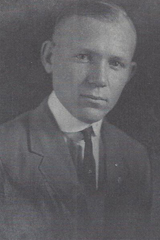 Mr. Eddie Fanick wasn’t always in the nursery business. He started out in the hard-goods business in San Antonio, and a t one time delivered milk for the Mistletoe Creamery using only a mule and wagon. In the 1920's he had a part-time business, Gardens of Iris, and he introduced a number of cultivars of bearded iris.
Mr. Eddie Fanick wasn’t always in the nursery business. He started out in the hard-goods business in San Antonio, and a t one time delivered milk for the Mistletoe Creamery using only a mule and wagon. In the 1920's he had a part-time business, Gardens of Iris, and he introduced a number of cultivars of bearded iris.
As he grew closer to horticulture - his true love in life - he leased some land in San Antonio in order to have more room to grow his plants. Then it happened. A Mexican woman in town gave him some seeds of a new red morning glory.
He grew plants from the seeds and harvested seeds of the impressive Scarlet O'Hara morning glory. On a buying trip to New York he was offered $900 for the valuable seeds. He took the money and bought an acre of land on what eventually became his nursery. After clearing the land he began planting more flower varieties and collecting their seeds. According to his son John, the elder Fanick spent many a night spading the land by moonlight or kerosene lantern light.
Around 1940, Mr. Fanick was offered the job of head gardener at the San Antonio Arsenal on the San Antonio River. Considering his love of flowers, the opportunity to be paid for working with them and the luxury of having a greenhouse was one opportunity Mr. Fanick couldn't afford to pass up. For nine years he practiced his art at the arsenal, now the site of corporate headquarters for HEB food stores. At the end of World War II, he was offered the opportunity of transferring or retiring. He chose retirement and built a house on Holmgreen Street where he still resides.
There he began raising iris, narcissus and other types of bulbs for their flowers as well as their bulbs. (Early each spring passersby can still see paperwhites and Chinese sacred lilies blooming beneath the rows of pecan trees across the street from the nursery.) He also raised seed from a number of flowers including morning glory, tithonia, cockscomb, periwinkle, gomphrena, honey daisy, standing cypress, cabbage, and assorted Texas wildflowers. His family, along with neighborhood women and children, helped harvest the seed which was then sold to local and national seed companies.
Mr. Fanick's next endeavor was raising cut flowers which he sold to local flower shops and flower stands. His son John recalls the family growing giant mums, zinnias, marigolds, stock, snapdragons and larkspur. Mr. Fanick even opened his own flower shop.
Around 1946, he expanded and opened Fanick’s Garden Center. In addition to selling locally adapted varieties of trees and shrubs along with his new introductions, he also grew and sold bedding plant transplants as well. The nursery business hasn't changed that much over the years, Mr. Fanick says. However, he points out, "We used to have a lot more varieties than we do now."
If you visit the nursery, don't be confused by the impression that old Mr. Fanick is a gentle "teddy bear." He's widely known for being enthusiastically caustic. He doesn't hesitate to get right to the point, and it's not unusual after pleasantly greeting his customers for him to respond to questions about certain plants in a tirade of ranting and raving. He might tell you that one particular tree is a (expletive-deleted) piece of trash, while proclaiming another as the best (expletive-deleted) plant on earth. People who have known him over the years have come to respect his honesty about plants.
Dr. Steve George, a landscape horticulturist for the Texas Extension Service, is a former Bexar County Extension horticulturist in San Antonio. "Mr. Fanick is the most honest and trustworthy nurseryman I have ever known," he says.
"He's the best damn nurseryman on earth," says Dr. Jerry Parsons, Extension horticulturist in San Antonio. "He's one of the biggest supporters the Extension Service has ever known.”
"While other nurserymen were complaining to maintain status quo, I've heard him say on numerous occasions, 'Parsons, I don't care what plant you promote, just keep promoting something because it brings'em into the nursery. We'll handle it from there."'
In an interview published in the San Antonio Light newspaper on his 81st birthday, Mr. Fanick was quoted as saying, "I want to have a purpose. I want to keep on going until the last day. Work keeps your mind going and you don't get stale. This way I don't let my joints rust. I'll never retire. As long as I can get up in the morning, I'll work.”
"As long as you're able to move, move, because there’ll be plenty of time to lie down later."
At 92, Mr. Fanick’s health is beginning to fail a bit. During a recent hospital stay battling an unexpected serious illness, Mr. Fanick amazed everyone in the room when he became alert and immediately reached for his glasses as a visitor (Greg Grant) walked in with a handful of assorted experimental flowers. It was a true testament to his undying love of plants.
He’s feeling well enough these days to tour his nursery by golf cart. The day I visited him last fall, he wanted to show me a pecan tree that a squirrel had planted and that he had grafted. After the tour he rested in his familiar spot, sitting on a pile of fertilizer bags just outside the front door of the nursery.
"Help yourself, look around, let the little lady look over the roses," he told a man and his young daughter entering the nursery that day. Although Mr. Fanick attended school only through the third grade, he's a firm believer in knowledge. He helped start the First Men's Garden Club and was a charter member of the organization. He's also a life member of the San Antonio Men's Garden Club and the National Men’s Garden Club. He’s very proud of a room full of reference books he accumulated over the years. "You've got to read about it to learn it," he insists.
He got out some of those books during our visit and showed me photographs and files from the nursery's past. As I was leaving I looked back to see Mr. Eddie Fanick sitting in his chair eating his dinner, gazing attentively at a nature show on the local PBS television station. Not many people get a chance to watch their hero in action. I just wish that every town had a Fanick's."'
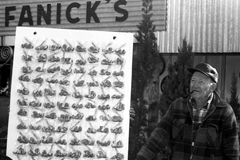
Fanick and Pecans
|
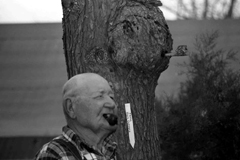
Fanick and Pipe Tree
|
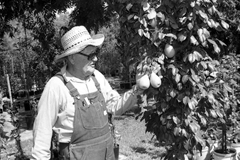
Fanick Pears
|
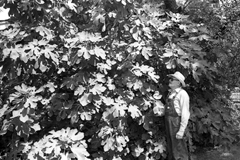
Fanick with Blue Giant Fig
|
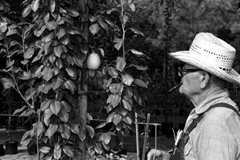
Fanick with FanStil Pear
|
About the author: in FEBRUARY, 1995 when this article was written, Greg Grant was adjunct director of education and product development for Lone Star Growers (now ColorSpot Nurseries in San Antonio). Greg is a former Bexar County Texas Agricultural Extension Service horticulturist and a frequent contributor to GARDENS Magazine. (NEIL SPERRY'S GARDENS)
|
|
|



